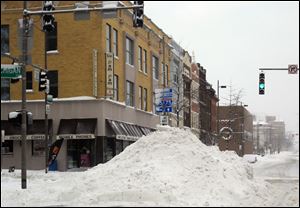
Frigid weather likely to take a bite out of local economy
1/7/2014
How big a hit the local economy has taken due to bad weather shutting communities down is impossible to determine, economists said.
For the average Toledoan, Monday’s snow emergency meant dealing with 8 inches of snowfall and subzero temperatures.
For the community as a whole, however, the combined snowstorm and frosty air that moved in Sunday likely will mean a hit to the local economy.
How big a hit is impossible to determine, economists said.
“Typically, bad weather does have an impact and if there’s sustained bad weather, it will become more challenging to weed through the data,”said George Mokrzan, chief economist for Huntington National Bank’s private financial group.
“My primary focus is the national economy, so I will be looking at that in the January data and the expectation is that things will look stronger in the first quarter. But if we get a little softer number it will make my job more challenging to determine how much of a factor the weather played,” Mr. Mokrzan said.\
RELATED ARTICLE: Some businesses see boon during polar blast
CLOSINGS: Municipalities, businesses, medical, schools, and services
The storm and cold “is probably going to take a little bite out of the [Toledo] economy,” agreed economist Ken Mayland of ClearView Economics in suburban Cleveland. “You have closings and reduction in activity that probably won’t be made up. There also will be some lost sales, so it’s probably going to take a nick out of the economy.”
Ohio and the Midwest are used to dealing with winter. “It’s not a huge impact because we have winter to some degree every year,” Mr. Mayland said. “But this is some extraordinary level of cold from the average temperature that we are experiencing.”
Because of the Level 3 snow emergency, which limited travel around Lucas County to emergency vehicles and authorized people for most of Monday, one shift at Chrysler’s Toledo Assembly Complex, where Jeeps are built, did not report for work.
Other businesses such as Owens Corning and Owens-Illinois Inc. were not operating Monday. Many banks and retail stores were closed. And while several grocery stores were open, snowy roads prevented fresh supplies from being delivered.
Kroger, for example, had truckloads of groceries parked outside Lucas County while roads were closed. Federal Express also did not allow its drivers on the road Monday.
“Those kind of slowdowns actually have measurable effects. On a national level in years when there’s been cold weather, it typically does affect things like retail sales, industrial production, and even GDP,” Mr. Mokrzan said.
“While those effects are temporary, typically there’s a sharp slowdown [in economic activity] followed by catch-up activity, which would probably be the case for automobile production and retail sales,” the economist said.
“Also, the longer it goes on also is a factor,” Mr. Mokrzan said. “If it lets up in a day, that will have minimal effects. But if it goes on ... .
“That may have an effect on supply constraints,” he said. “Toledo produces a lot of things. The other cities in Ohio are also experiencing cold. If the cold continues, then we start talking about supply bottlenecks.”
Mr. Mayland, who studied meteorology in college in addition to economics, said there undoubtedly will be winners and losers this week in the Toledo economy because of the snow and freezing temperatures.
“The department stores selling sweaters and coats and gloves and hats are probably having their inventory cleared out — which is a good thing. Last winter was mild and they got stuck with that inventory,” Mr. Mayland said. “This winter that stuff’s probably going to sell and sell out at good prices.”
Also, retailers selling snow shovels, plows, snow blowers, salt, and other items for dealing with snow probably will be happy with their sales. “That’s all seasonal stuff and is probably selling pretty well,” the economist said.
“The consumer, though, is going to take a little hit on this,” Mr. Mayland said. “With this season, the whole season may be 4 to 8 degrees below normal when it ends. That means you’re spending more on heating fuels — electricity, natural gas, heating oil.
“You’re using more and you’re going to spend more for it and that’s less money in your pocket to spend somewhere else,” Mr. Mayland said.
Contact Jon Chavez at: jchavez@theblade.com or 419-724-6128.